Affiliate disclosure: This post may contain affiliate links. Please see our Privacy Policy.
Growing lemon trees from seed is simple, and they thrive with minimal care indoors (or outside in warm locations).
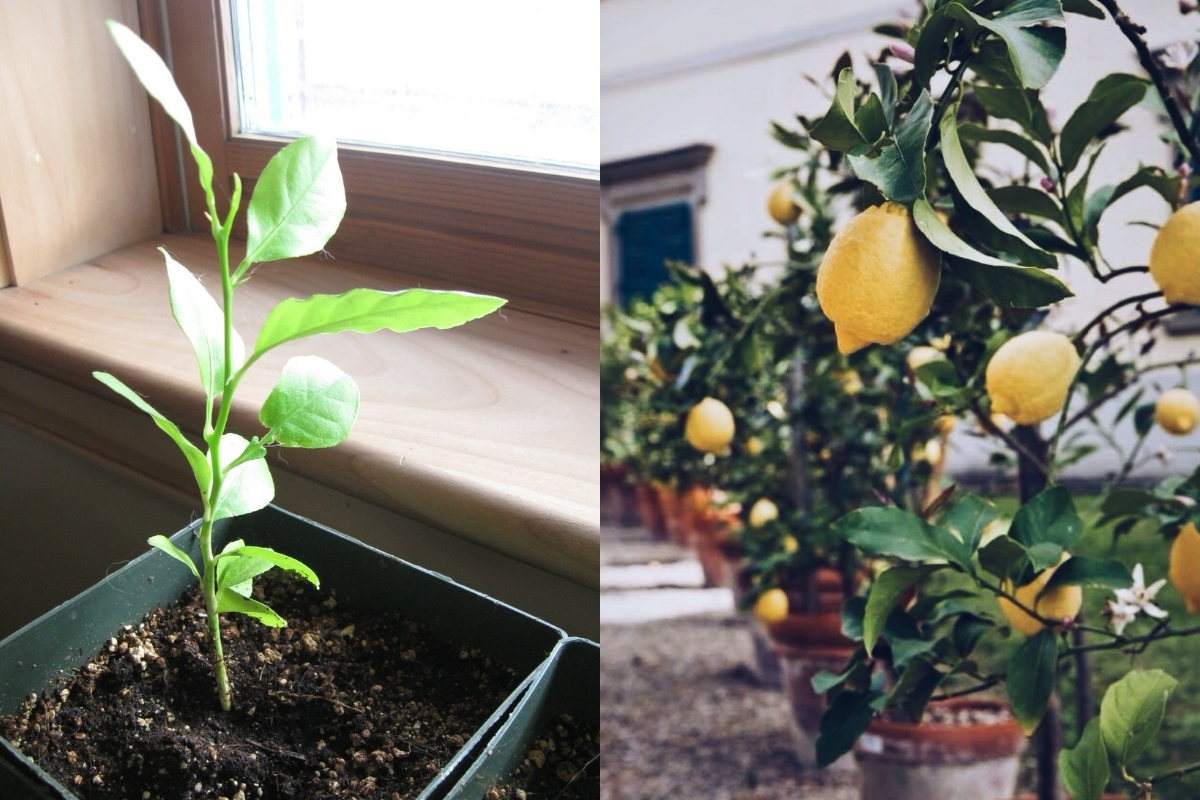
Lemons are a great way to add flavor and bright acidity to home-cooked meals. Beyond our everyday cooking, I use them by the dozen making homemade limoncello. I also usually add a squeeze of fresh lemon juice to homemade jam recipes, to both balance the sugar and add pectin to help the jam set.
All of that adds up to a lot of lemons in a year, which in turn means a lot of lemon seeds.
I always felt bad just composting them. Why not plant lemon seeds instead?
It turns out, lemon trees are incredibly easy to grow from seed. The seeds germinate so easily that some people plant them by the cup full and grow them as a potpourri (since the young leaves are so fragrant).
Lemon leaf potpourri might be a nice novelty, but I’m more interested in growing lemon trees from seed. About a decade ago I started planting lemon seeds and raising lemon trees at home so I could harvest our own homegrown lemons.
The trees aren’t exactly hardy here in Vermont, but growing lemon trees in pots allows you to bring them indoors during the winter months.
These fast-growing trees go from seedling to producing full-sized lemons in about 3 years, so it’s well worth the effort.
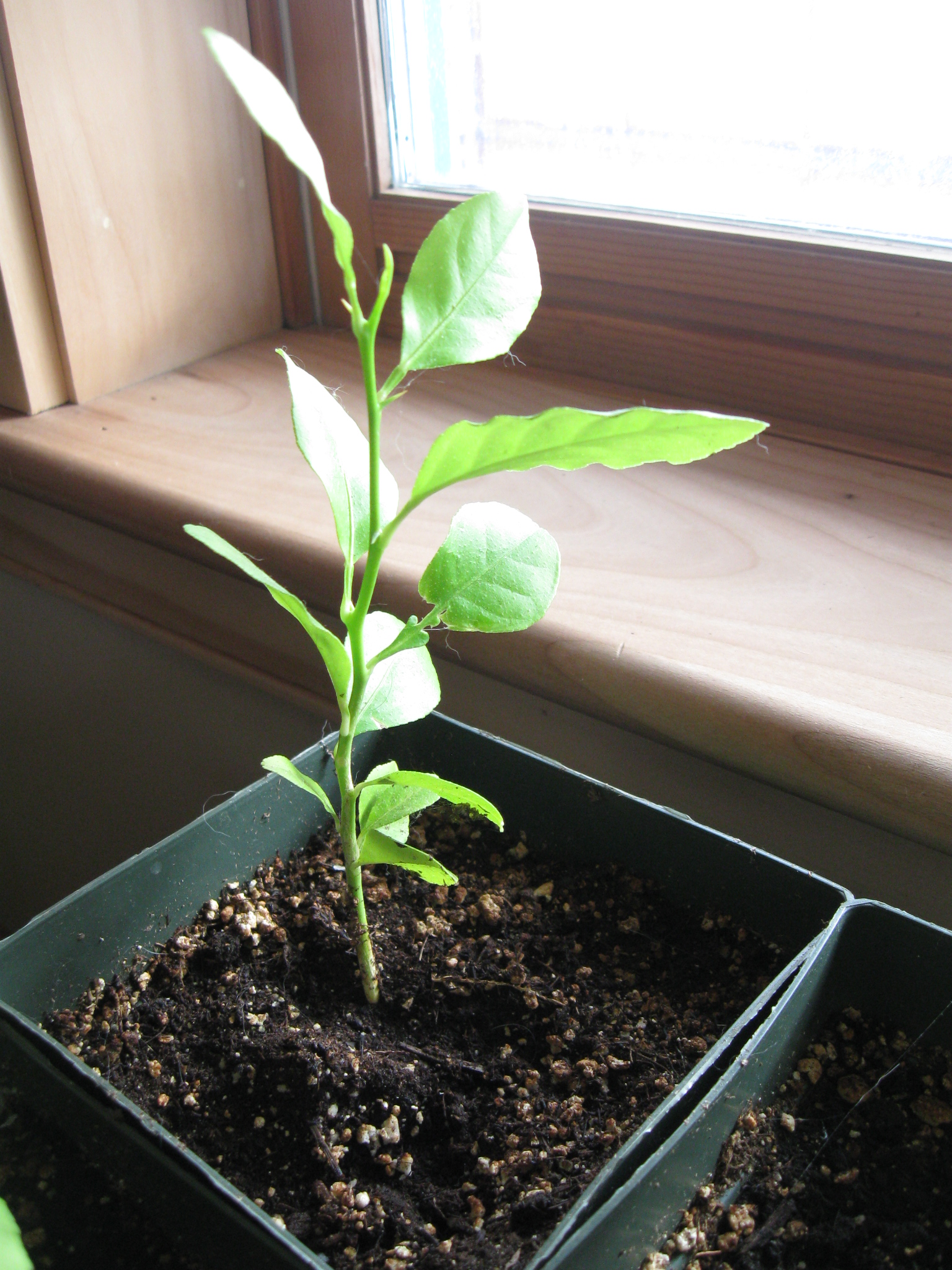
Growing Lemon Trees from Seed
Growing a lemon tree from seed, whether it eventually produces fruit or not, is a worthwhile endeavor if you’re curious about propagating seeds or learning how citrus trees grow. They’re fun houseplants that are not only beautiful but the leaves and foliage smell wonderful.
The actual fruit is just the icing on the cake, but it doesn’t take much to get them to produce.
Grown indoors, lemon trees will typically produce fruit after 2 to 3 years. Sometimes you’ll get a tree that doesn’t end up growing lemons, but that doesn’t mean the tree itself is a lemon, so to speak, as tending to a fruit-less lemon plant is still a pleasant and rewarding experience.
All you need to get started is a healthy-looking, juicy lemon (more specifically, its seeds). If possible, choose an organic lemon, or one that hasn’t been treated with pesticides.
Remove the seeds from a cut lemon carefully, they need to be intact (read: no cuts) when planted. I use my fingers to remove them from the fruit and then rinse them off using cool water, you want to get rid of any remaining pulp as the residual sugar causes fungus to grow, which in turn leads to seed rot.
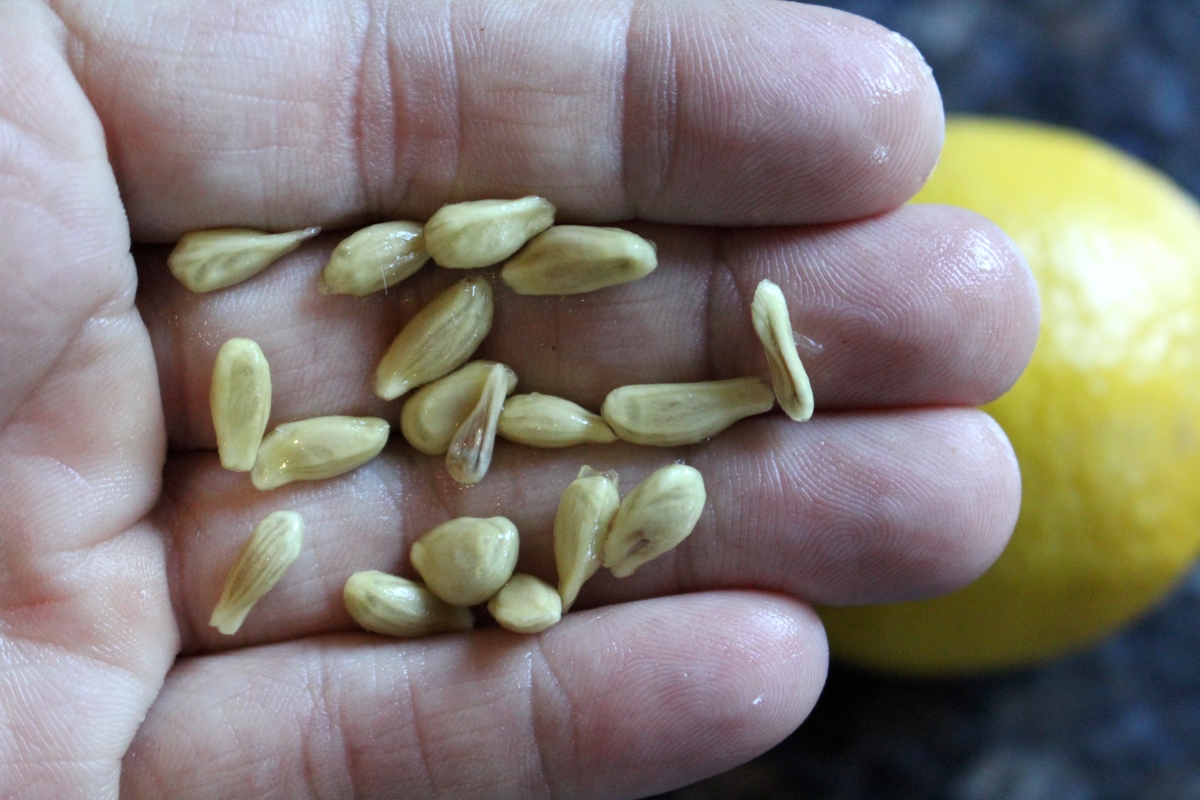
Lemon Tree Seed Germination
Unlike some seeds that require a germination period in paper towel or water, lemon seeds should be planted as soon as they’ve been rinsed.
Try not to let them dry out, they should still be wet when planted.
Plant the wet lemon seeds in a small pot with drainage holes, using pasteurized soil mix (the pasteurization part is important, as it improves the likelihood your lemon seeds will grow without issue).
At this point in the process, you can plant several seeds in a single pot. The seeds only need to be planted a 1/2-inch deep to successfully propagate, the soil should be gently moistened with water and the container covered with plastic wrap to keep the growing environment damp but not wet.
The growing lemon seeds need to be kept in warm environment, about 70° F, during the initial germination period. If your house runs cold, the top of the refrigerator is a good place to keep the pots.
Depending on the seeds and growing conditions, you should see growth in 1 to 3 weeks.
As soon as you notice the seedlings poking through the soil, remove the plastic wrap and place the pot in a warm, bright location. When the seedlings have grown several leaves, it’s time to transplant them to larger potting containers.
Using the same pasteurized soil mix as before, carefully move the seedings into containers that are 4 to 6 inches in diameter.
As the tree grows, replant it in a larger container to match its size and give the plant a good pruning in the spring.
Lemon Tree Care
The planted, germinated seedlings should be placed in a location where they’ll receive at least 6 hours of sunlight during the day, at a temperature between 60° and 70° F.
Keep the soil moist by watering when the top 2 to 3 inches feels dry, you can test this by sticking your finger directly into the soil and feeling for wetness. Like other plants, when lemon trees need water the leaves will begin to droop.
Unless you live in a truly cold climate, bring your lemon trees outside when the warm weather hits. Even if this is only for a few months, the steady, direct sun will make it so your trees are more likely to eventually produce fruit.
I’m fortunate, also, that we have a small greenhouse built off of the side of the house, which is where we keep our potted lemon trees throughout the spring and autumn months. The greenhouse extends their “outdoor” time, but we still have to bring them indoors for the coldest part of winter.
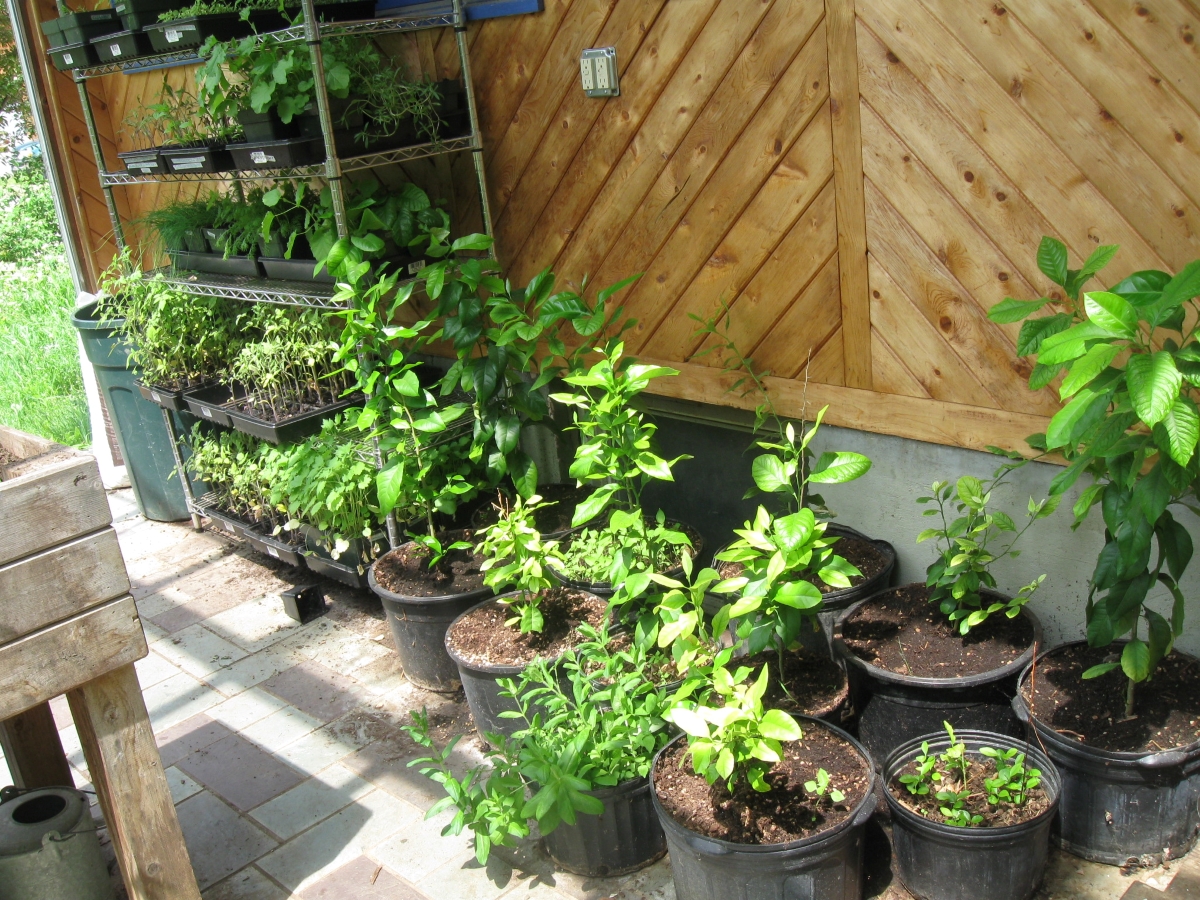
Lemon Tree Hardiness
Lemon trees are usually hardy to zone 9, meaning they can handle a very occasional light frost. They’ll take damage if the temps go below 32 F (or 0 C), but most can survive to 28 F (or -2 C). Some trees are a bit tougher and can make it as low as 22 F (or -5 C), but it’s best not to risk it.
When you see a frost warning in your area, it’s time to bring your lemon trees indoors for the season.
Best Fertilizer for Indoor Lemon Trees
You can keep your lemon trees happy during the warmer months by feeding them a water-soluble nitrogen- and potassium-rich fertilizer every two to four weeks, making sure the surrounding soil stays nice and moist (but not overwatered or soggy).
A common mistake is to apply fertilizer to lemon trees in winter when they’re indoors. People see the trees dropping leaves and panic. They start watering more and add fertilizer, which is just the opposite of what the trees need.
If the trees start to drop leaves indoors in the winter, reduce watering, stop fertilizing and allow the trees to go dormant. They’ll perk right back up in the spring once they’re in bright light again.
Winter Lemon Tree Care
The type of lemon tree winter care your plants need is entirely dependent on where you live, ambient temperature, and light exposure. So, for example, if you’re from a warm locale such as California or Florida, you can keep lemon tree plants outside in their pots all year long.
On the other hand, if you’re living in a cooler climate where the days get very short during the winter, it’s vital that the plants are brought indoors during that time. Keep the trees in a warm, draft-free location inside.
Reduce the watering schedule and cease fertilizer applications, waiting to resume until the following spring.
Here in Vermont, we keep our lemon trees indoors for the winter for about 4 months of the year.
As you can see in the photos, the greenhouse is an ideal place to grow citrus trees indoors during the shoulder seasons. The main idea is to avoid frost, so bring in the lemon trees before the first frost and after the (hopefully) last frost of the winter.
It’s normal, and in fact healthy, for plants to undergo a state of dormancy during this time. You might find the lemon tree stops growing or it loses some of its leaves; this is your plant’s way of conserving its energy and isn’t something to be worried about.
Once the weather warms up and the sunlight increases your lemon tree will begin to grow with gusto once more.
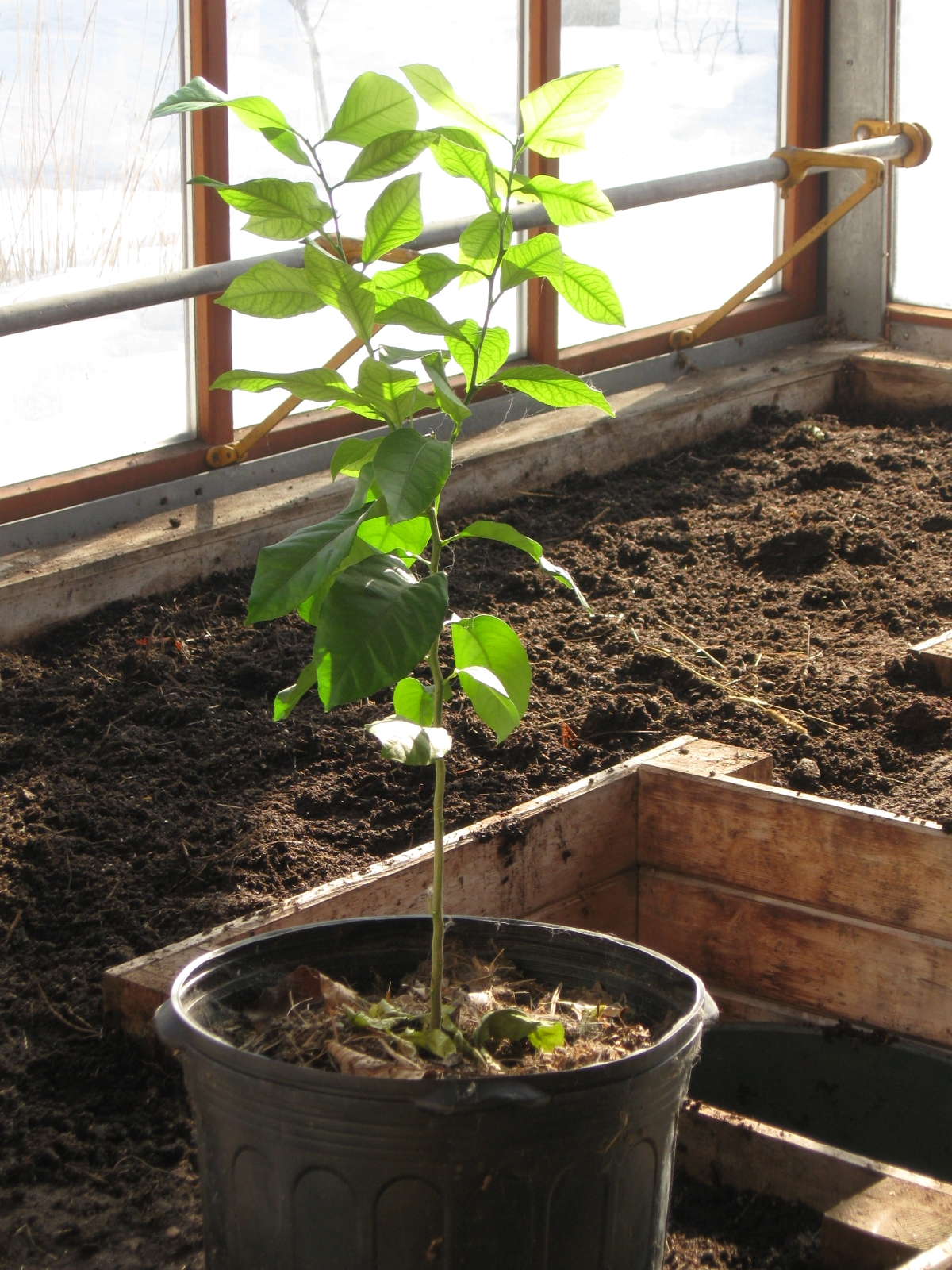
Harvesting and Using Lemons
After a period of 1 to 3 years, your lemon tree might begin to produce fruit. Lemons can take up to 6 month to ripen, depending on the variety, and are ready to be picked when they have firm, glossy skin and are 2 to 3 inches in size.
If you’re growing lemons from seed in a colder climate, your lemon crop will be small.
If, however, you lived in warmer part of the United States (or any other warm climate), you’ll be able to harvest lemons by the bucketload.
In either case, preserving lemons by one means or another is a fantastic way to hang on to that “fresh from the tree” flavor. My favorite and most hands-off way of preserving lemons is to make limoncello, a traditional sweet-tart Italian digestif that can be sipped on its own after a meal or mixed into a cocktail (like this effervescent drink made with limoncello, prosecco, and sparkling lemon soda).
Looking for more ways to preserve the fruits of your labor? Check out these options:
- Homemade Lemon Wine
- Finnish Fermented Lemonade (Sima)
- Canning Lemons (Three Ways)
- Preserved Lemons (Lemon Confit)
- Canning Lemon Curd
- 20+ Ways to Preserve Lemons
Seedling Growing Guides
Try growing other perennial plants and trees from seed!
- Growing Strawberries from Seed
- Growing Rhubarb From Seed
- Growing Asparagus from Seed
- Growing Apple Trees from Seed
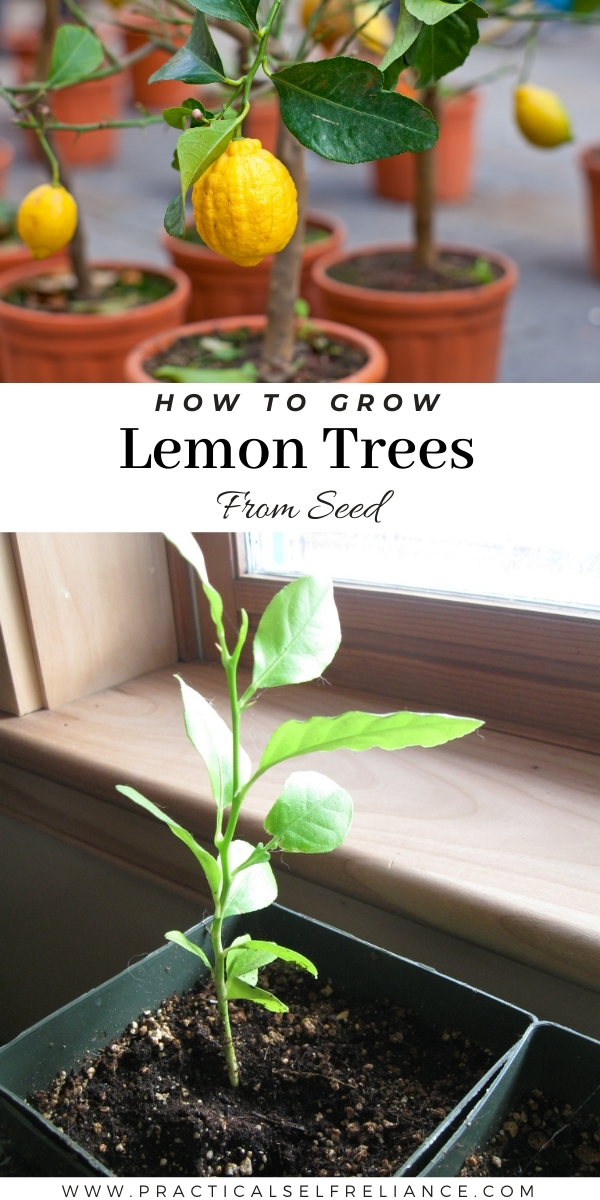
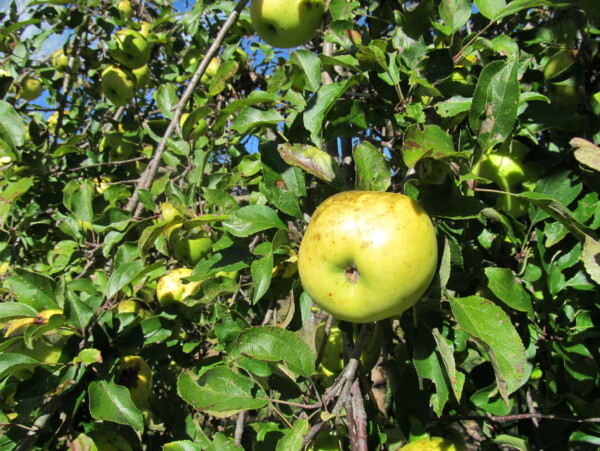













Hi,
I live in Cheshire, Uk and was gifted a lemon seed plant at Xmas. It is now aprox 12 inches high with a lot of new leaves growing.
What size pot would you suggest I need for this ?
I have it in a 5 x5 inch pot at the moment and is kept indoors.
Would appreciate your advice
Many thanks
Sylvia
It’s about time to move it to a 1 gallon pot and that should hold it for the next year or so, and then you may want to move up to a 2 gallon in year 3-4ish depending on how fast you’re seeing growth. Best of luck with it!
Fertilize year round – when grown in containers
Thank you
I am live in the North West of the United kingdom. I have planted lemon seeds and now have 10 seedlings. Living here do I have to care for them in any special way?
I would be grateful for any advice you have on raising these! Thank you.
If you are in a more northern climate you would probably be best to grow them in containers so that you can bring them inside for the winter.
I initially planted two seeds in one pot and they are both doing well indoors. How can I safely separate the two? I thought I would wait until the weather warms (I’m in PA) and I can put them outside in case they suffer any trauma from separation? Any tips?!
These are my babies and I started using your article so thank you!!
They may do better if you try to separate them inside and then give them some time before transitioning to the outside. That way they are only dealing with one transition at a time.
How deep should the 6inch diameter flower pot
Be when the seedlings sprout s are first transplanted?
It doesn’t need to be super deep but you want the roots to have plenty of room to grow.
What months do you recommend starting the lemon seeds?
The best time to plant is a few weeks before the last frost but they can be planted anytime.
I have a larger lemon tree that sadly suffered this winter because the only good room to winter over plants is our new baby nursery! I did my best in another spot in my home but It lost ALL of its leave. I kept light watering all winter but do you think there is hope? Some branches are still green in color (some branches are Cleary dead though sadly). I hope it isn’t totally kaput!
Yes, the same thing happened to me and after several weeks on the front porch, it has started to grow some new leaves.
Same thing happened to me but I took them outside when all danger of frost was over and they are getting new leaves.
Very HELPFUL thank you!
You’re very welcome.
I am planning to plant some lemon seeds within the next week. I realize it’ll take a while to grow and have blooms. If I have it outside during the warm months, will I need to hand pollinate or will the honey bees living in a tree in my yard take care of that? Thank you!
As long as they are outside, you shouldn’t have to worry about hand pollinating.
Hello! I want to try this! What do you do about those pesky gnats that live in the soil when plants are outdoors and you bring them indoors? My house gets infested with them!
Those are usually only a major problem if plants are overwatered. Try re-potting them in new soil before you bring them in, and cutting back on the water once indoors.
I just grew a lemon tree from seed this year. I used a non organic regular lemon. I am not a fan of Meyer lemons. My biggest concern is that I am growing a GMO lemon tree that will not produce fruit. Even if that is the case, I am enjoying the process. Great article. Thanks!
You’re welcome. Glad you enjoyed the post and good luck with your lemon tree.
Citrus, unlike most fruits, frequently comes “true to type” from seed. Cultivars vary widely in this trait. Dancy tangerine comes true to type in close to 100% of the time. Others like Temple tangor produce no true to type seedlings.
Being true to type, Citrus seedlings will still need through a period of juvenility before the onset of the mature, reproductive phase begins. Once in the reproductive phase, the trees should flower and produce fruit for the duration of their lifespan.
I started my seed April 2021 put it in pot April 26. 2021. I put in the garage during the winter. I put it outside when there was no danger of frost. My trees are growing one is about 4 feet and the other one two feet. I only fertilized once.
That’s wonderful. Thanks so much for sharing.
Glad I stumbled on to this website/blog – I’m getting ready to plant sprouted apple seeds today.
A year ago, I was gifted a lemon (or lime?) tree grown from seed. it was only about a foot tall, now it is 4 feet tall, having spent most of its time outside in Vancouver. Washington! Despite our cooler weather, its still trooping along, and some slight damage from recent below freezing temps. It sits next to a sunny stucco wall outside. At any rate, how do I prune this thing? I want to give it better growing conditions, – put it in a bigger pot, removes thorns and help it to start branching out. So far, it is straight as a pin with green leaves and thorns. Help please.
Its a survivor to be sure!
You should prune the branches by no more than 1/3. If you find it absolutely necessary to remove some of the thorns you can, but removing them won’t benefit the tree in any way and you could potentially damage the tree by doing so.
Just wondering what is meant by “pasteurized soil mix”? what are some brand names or what should it say on the bag? I have never seen a bag that says “Pasteurized soil” on it…..
Any soil that you purchase should automatically be pasteurized. I have also heard of people pasteurizing their own soil at home by heating but it’s a bit of a pain.
When I moved from CA to the Midwest, I grew 2 Eureka lemons indoors for at least 8 years. I contended with citrus scale every winter and gave the trees a bath with soapy water at least twice per year.. In warmer months, when they were outdoors, some local bugs dined on the scale and they would grow beautifully. I think if I had grown them from seed, instead of bringing them from CA, I would have avoided that scale. If I didn’t travel so much, I would grow another. Nothing smells quite like a citrus tree in bloom, and they bloomed for weeks on end in my south facing windows. I did hand pollinate with a quick spin of a q-tip. They did drop a bit of sticky sap on the pots and rug, and would have done so without the scale, but that is the nature of citrus trees. A friend with an orchard encouraged me to roll them outside on days that were around 45 degrees, to sweeten the fruit a bit.
Thank you so much for sharing that.
Interesting article – thank you! I always thought citrus had to be propagated on special rootstock so never tried to grow them from seed. Do you know if the same technique works for other citrus fruit like oranges, limes, calamansi, tangerines etc?
They only need to be grafted if you want a tree that is identical to the parent. The same technique should work for other fruit trees as well.
My lemon from seed is roughly 3 years old and just over 2 ft..it has yet to branch. Do I prune it or leave it alone?
I think I would leave it at this point.
You mentioned pruning the lemon plants in the spring. Could you speak to how that is done?
Thanks! 😊
I found a great article here that describes the process for both indoor and outdoor lemon trees. https://minnetonkaorchards.com/how-to-prune-a-lemon-tree/
This article was really helpful, thank you. I inherited a lemon tree last October and it was full of near ripe lemons. The tree went through a period of shock when I transplanted it, but is doing great now. I’m in Illinois and just brought it indoors. It is full of flowers that are about to bloom. Last year I hand pollinated the tree. All the tiny lemons fell off before I ever took the tree back outside in the spring. Should I hand pollinate during the winter when it blooms? Thank you!
Yes, you will need to hand pollinate your lemon tree when it is indoors.
I decided to try and grow a lemon tree from an organic Meyer lemon. It has been extremel easy.. I cannot believe how rewarding it is to see this tree grow. Its only been 6 month and the lemon tree has started growing thorns. Is that normal? Do I cut them off? I never knew lemon trees had thorns.
Yes, it’s true that most citrus trees do have thorns. This helps to protect the tender foliage from predators. Often times the thorns may go away when the tree is more mature. It is not necessary to cut them off but it also shouldn’t hurt to cut them off either.